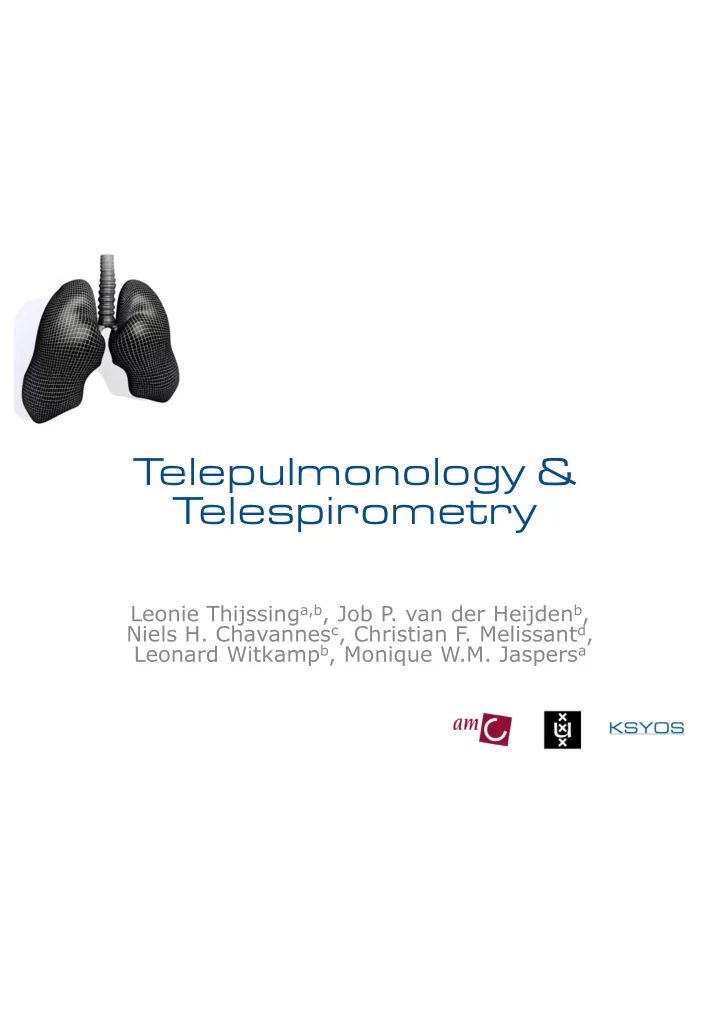

Telepulmonology & Telespirometry Leonie Thijssing a,b , Job P. van der Heijden b , Niels H. Chavannes c , Christian F. Melissant d , Leonard Witkamp b , Monique W.M. Jaspers a
Introduction Leonie Thijssing, PhD Student � KSYOS Health Management Research & Academic Medical � Center Amsterdam Research revolves around telemedicine applications within � the field of respiratory medicine
Introduction � COPD � Fourth leading cause of death worldwide � Under- and misdiagnosis � Spirometry � Sufficient quality � Interpretation
Introduction Clinically significant disagreements between GP’s and � pulmonologists in 49 out of 168 tests (Kappa=0.39) 1 20% of 1.044 patients diagnosed with COPD in primary � care, spirometry test results did not indicate COPD 2 Need for ongoing support � 1 P . White, W. Wong, T. Flemin and B. Gray, Primary care spirometry : test quality and the feasibility and usefulness of specialist reporting, Br J Gen Pract 2007, 701-5 2 M. Strong, A. Green. E. Goyder, G. Miles, A.C.K. Lee, G. Basran and J. Cooke Accuracy of diagnosis and classification of COPD in primary and specialist nurse-led respiratory care in Rotherham, UK: a cross-sectional study, Prim Care Respir J 23 (2014)
Introduction Telespirometry – monitoring and improving quality of � spirometry tests Telepulmonology – supporting GP’s in interpreting � spirometry tests (diagnosis and treatment)
Introduction Telespirometry � What is the quality of the spirometry tests taken in daily primary care � practice according to pulmonologists? What is the interobserver agreement on diagnostic findings between � the pulmonologist and the GP/practice nurse? Telepulmonology � Are GP’s helped by telepulmonology in their decision making on � diagnosis and in setting treatment plans? Do GP’s learn from the telepulmonology consults? � Are unnecessary physical referrals prevented? �
Methods Up to 10% Biometrist Telespirometry Pulmonologist Grader Pulmonologist GP Telepulmonology Up to 2x Repsonse within 2 days
Introduction
Methods - Inclusion All GP’s in the Netherlands were eligible to start using � telepulmonology GP’s decided for which patients � Routine clinical practice � Oral informed consent �
Methods - Telepulmonology Four questions were posed on sending and closing the TPC: � Q1: Without telepulmonology, would you have physically referred • this patient to the pulmonologist? Q2: Do you now refer this patient physically to the pulmonologist? • Q3: ¡Did ¡you ¡learn ¡from ¡the ¡pulmonologist’s ¡response? • Q4: ¡Are ¡you ¡and ¡your ¡patient ¡helped ¡with ¡the ¡pulmonologist’s ¡ • response? Percentage of prevented physical referrals • Additional referrals • Educational effect •
Results - Telespirometry Dec 2011-Jan 2014 � 227 telespirometry tests presented to one of 8 � pulmonologists Quality of the spirometry test � Good 69% � Quality Moderate 23% � Bad 8% � Kappa interobserver agreement � Good on diagnostic findings 0.38 Moderate Bad
Results - Telepulmonology April 2009 – Jan 2014 � 4.488 TPC’s sent by 342 GP’s to 43 pulmonologists � 3.126 TPC’s answers of the GP available � Overall decrease in physical referrals of 22% � 3500 3000 2500 2000 1500 Not physically 1000 referred 500 Physically 0 referred Prior to Sent to Sent for After TC TC prevent advice a physical referral
Results - Telepulmonology Did you learn from the pulmonologist’s response? � 10 Yes 22 Slightly 68 No Are you and your patient helped with the pulmonologist’s � response? 4 Yes 24 Slightly 72 No
Discussion Only moderate agreement between grader and � pulmonologist (Kappa 0.38) Two thirds of the spirometry tests quality classified as good � Consistent with previous studies � Illustrating an ongoing need for support � High percentage of TPC’s sent for advice confirms this � 90% indicated (s)he learned � Over 95% indicated (s)he and the patient were helped �
Discussion Telepulmonology prevents unnecessary physical referrals � Triaged the right patients to be physically referred � Making the quality of spirometry tests transparent can help � in determining who could benefit from additional training Future research: does the combination of telespirometry � and targeted additional training increase the quality of spirometry tests?
Thank you for your attention! l.thijssing@amc.uva.nl
Recommend
More recommend